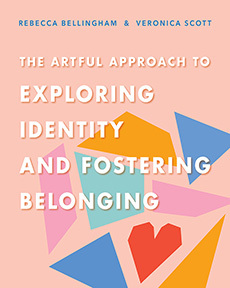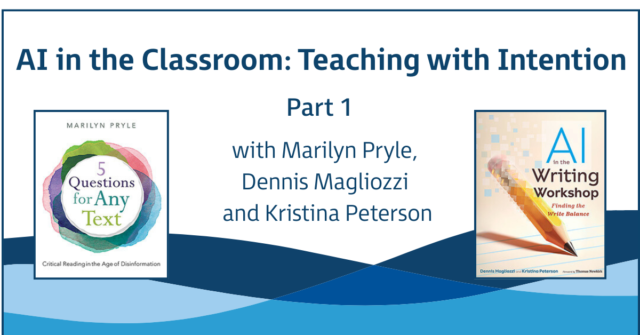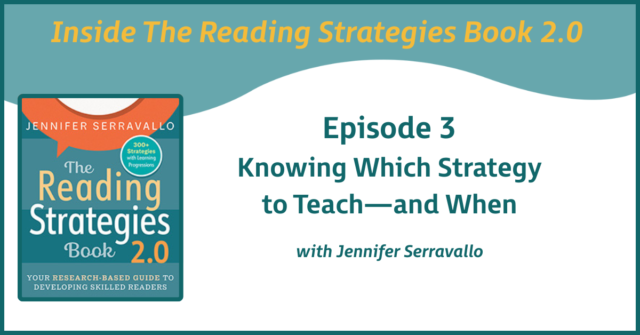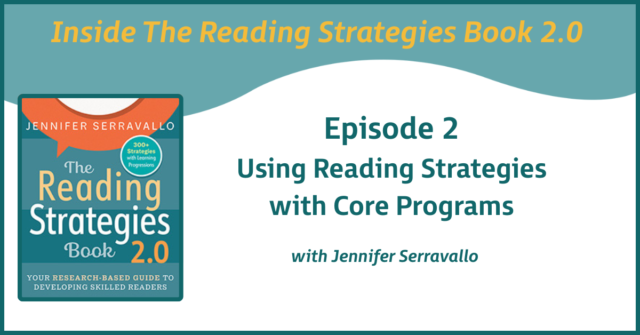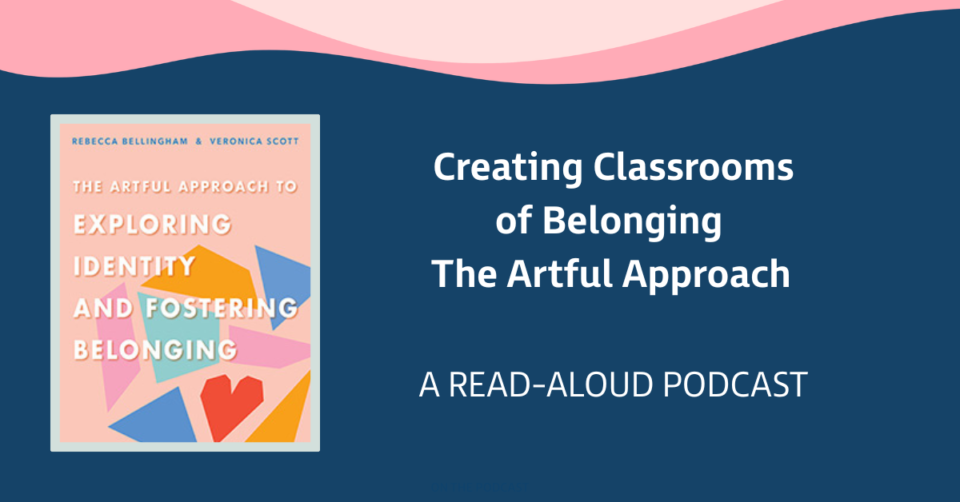
Every student deserves to feel seen, valued, and free to be themselves, and this week's Heinemann podcast episode explores how educators can make that happen through the power of the arts. Tune in as Rebecca Bellingham and Veronica Scott read the introduction to their new book, The Artful Approach to Exploring Identity and Fostering Belonging. Blending personal stories, creative strategies, and practical tools, the book offers K - 8 educators powerful ways to use poetry, music and storytelling to build inclusive connected classrooms. Whether you're looking to deepen identity work or add joy and creativity to your teaching, this episode will leave you inspired and ready to act.
Transcript
Rebecca:
"For the poets, dreamers, visionaries, and risk-takers who planted light in the field of darkness so we could rise up." Joy Harjo, Perhaps the World Ends Here.
Without fail, whenever we are knee-deep in planning mode, whether we're working on a poetry workshop for teachers or an artist studio for second-graders, there's this inevitable moment of doubt that arises and we realize we're both thinking the same unhelpful thing. Is this going to be enough? Will another one of these projects even make a difference? As lifelong educators, there's nothing we want more than to offer something of value, something practical and inspiring, something hopeful to lift up the teachers or students we're supporting. But as much as we try to hold on to that hope, especially on days when the headlines are particularly horrifying or when communities seem even more divided than usual, the world's capital P problems keep pushing their way into our optimistic lesson plans.
For every creative light bulb that goes off, there's a parenthetical what about lurking in its shadow. Maybe we can write a community poem, but what about the literacy crisis? Maybe we can paint a neighborhood mural, but what about basic needs? Maybe we can take time to reflect as a team, but what about teacher burnout? Maybe we can bring our school together with a song, but what about the upcoming election? Maybe we can have a dance party to celebrate women's history month, but what about pay inequity and the growing threat against women's rights? Before we know it, we're headed for a what about downward spiral.
Maybe you've been there. Maybe you've had a similar experience or train of thought. If we can't solve the big stuff, then what's the point of all these smaller efforts? And the truth is a community poem is not going to fix our broken world, but where would we be if in our toughest times, we didn't have songs to turn to, movies to transport us, poems to unite us? We only have to look back at some of the most pivotal moments in recent history to notice a link between movements and music or art and activism or literature and enlightenment. As Amanda Gorman says, poetry and language are often at the heartbeat of movements for change.
The arts empower people to rise up. They make space for the harmonious and the discordant. They offer us moments of beauty and joy in the midst of turmoil and glimpses of hope in the midst of uncertainty. They can help us share who we are and who we mean to be, honoring all our distinct complexities and glorious particularities in between. The arts move us, sustain us, and awaken us, and if we're not connecting or creating, it can often feel like we're doing little more than surviving.
Even if we don't see ourselves as artists, we are probably more creative than we realize. Whether it's writing the next great novel or making a luscious omelet out of the leftovers from the fridge, our lives are full of opportunities to create, and these moments of creating, both big and small, bring us alive. They fuel our work and uplift our spirits, and they can do the same for students too.
Our classrooms can be hubs of connecting and creating as well. When we invite the arts into our school day, we help students learn how to pay close attention and listen generously, how to speak up when it matters, even how to find their own brief moments of beauty and joy when they need them the most. Every time we bring out the crayons or lead the song, invite the class to paint a self-portrait or write their first line of poetry, we're breathing life into our classrooms. We're shining a light on what could be and inspiring our students to shine it right back at us, into their projects, into the hallways, and out into the world.
Veronica:
A coffee break. Let's get to know each other. Before we dive into how this book can help you harness the power of the arts in fresh ways, we thought we'd take a little coffee break for you to get to know us a bit. Here's the origin story of how we met, our very own mini Meet Cute. By sharing this backstory, we hope to provide insight into how our friendship and partnership inform our work, how we lean into our different backgrounds and perspectives as a way to model honest conversations and lead collaboratively.
When it comes to making new adult friendships, options can be limited. There are book clubs and coffee shops, the gym and the crafting aisle. One can hold out hope for a new neighbor or an organic run-in at the park, and of course, there's always the awkward setup from a well-meaning colleague, or if you're up for it, the apps. Our story, however, is a bit more unlikely. If we were sitting on the When Harry Met Sally Couch, our friendship story might be closer to the couple with all the odds stacked against them. Different generations, different cultural references, different upbringings, different races, different households, one with twins, one with a visiting neighborhood cat, and as would become clear in our shared office space, different organizational habits.
One of us likes books arranged a certain way, which she would say is the right way, and one of us takes what she would say is a more laissez-faire approach. Not only were we from seemingly different worlds - Rebecca is a white Jewish woman with small town Midwestern roots, and Veronica is a Black Chicana from the multicultural sprawl of Houston, Texas - but the circumstances of our meeting were also weighted with complexity.
We met launching equity work at a new school months after an international racial reckoning, in the height of a pandemic, and yet, within days of meeting, we realized we were kindred spirits. We would soon discover we both love Broadway and all things New York City. We both love books, bookstores, and a general bookish vibe. We both love comparing notes on the latest think pieces, everything from the state of diversity, equity, inclusion, and belonging in education to who is most deserving of this year's best picture. We are both children's lit fangirls and have strong opinions about classroom decor, and we both remember thinking at the end of our first epic text exchange, "Thank God you overthink everything too."
As we got to know each other better, we realized that we had some deeper connections as well. We both believed in the power of the arts to create classroom magic. We both wanted schools to be places where students felt free enough to be their unique selves, and teachers felt inspired and supported enough to make that possible. We both dreamed of classrooms where children could express themselves not only with words, but with color, song and movement too.
Rebecca:
In those first few months, we would find ourselves meeting in the office or waiting in the school lunch line, deep in discussion about these ideas. We wondered if our two roles, literacy specialist and DEIB director, could work together towards building this dream of belonging for all students. In these conversations, we soon realized another deep connection. Not only were we both educators, but we were also artists.
Rebecca, a performer and playwright, and Veronica, a fashion designer and stylist, had both witnessed the impact of the arts firsthand, and as teaching artists, we had also witnessed the way the arts could transform the lives of young people too. We decided we would integrate our creativity and love for theater, music, and poetry into our work. In these early conversations, we began to dream up what would become our artful approach to exploring identity and fostering belonging.
Given our love for the arts, we just had to stuff this book full of some of our favorite stories, cultural references, artists and icons. Alongside practical user-friendly guides, you'll also discover the Cholita climbers, Nick Cave Sound Suits, Ashley Bryan puppets, and how to use Nikki Giovanni's poem about chocolate to launch an express yourself-themed Black History Month. We also want to lift up people, places, and movements that rarely make their way into elementary classrooms. Yuyi Morales, Afrofuturism, powwow remixes by Halluci Nation, Sean Sherman, aka the sioux chef, Duke Kahanamoku, the father of surfing, all make an appearance, and we had to include a few mic drop moments of Ta-Nehisi Coates as well. Alongside these new and familiar voices, you'll find poems about everything from fearlessly swimming with sharks to rolling out masa with grandma, and full disclaimer, there's also one-minute dance parties, a quick mention of The Bachelor, and theater kid energy sprinkled throughout.
In addition to all these spotlight stories that students will love, we also share teacher tips for launching the year artfully, checking in at every season, and responding to challenging moments that arise throughout the year. Every chapter includes charts to guide your planning, as well as many scripts that you can adapt to help you frame some of these big ideas in developmentally appropriate ways. You'll also find samples of lesson plans and student work to help you envision how these ideas come to life at different grade levels.
Veronica:
While we encourage you to begin with the first chapter, Learning for Self-Growth, picture books, poems, and pop culture, you can definitely read this book out of order. For instance, you might find it useful to dive into specific chapters that can help you think about upcoming units or how to support student conversations around identity as they arise. Or maybe you'll want to pull an idea from one of our go-to lists to use for an upcoming project or meetup, like True for Me, a game for connecting with students, or elevated watercooler conversation starters, which has fun questions for connecting with your colleagues, or identity maps with a twist, which can be adapted to explore identity with students or adults.
Like a pep talk with a work friend at just the right moment, we hope this book leaves you feeling energized, supported, and inspired. We hope it leaves you feeling like you have allies and co-conspirators in this work, like you're ready to bring a whole new lens for the kind of stories that can spark engagement in your students. Like it's okay to start with the small and artful shifts that grow into a more significant impact over time. Like when you draw inspiration from the arts, the possibilities for creating, connecting, and belonging are limitless. Like there is joy in leading this work, and you deserve to take it in, soak it up, celebrate the wins. Take a moment to quiet those voices of doubt, to shush those what abouts lurking in the shadows, and to say to them, "This is enough. This matters." Because a community poem might not fix our broken world, but it sure is a good place to start.
Rebecca:
To learn more about how to connect with your students and how to partner with books to explore identity, check out our new book.
Edie:
Thanks so much for tuning in today. You can read a full transcript and order Rebecca and Veronica's new book at blog.heinemann.com.
ABOUT THE AUTHORS

Rebecca Bellingham is equal parts educator and artist. She has led literacy and arts-based work in schools, universities, and nonprofits for over 25 years. She is the author of The Artful Read Aloud and co-author of The Artful Approach to Exploring Identity and Fostering Belonging. Along with her writing partner, Veronica Scott, Rebecca is the co-founder of Artful Belonging Studio, a consulting firm and creative studio. She wrote the book for the folk musical play, The Raft, which is currently in development for production.

Veronica Scott (she/her) discovered a love for teaching as an EdTech coordinator and K-6 teacher. Most recently, she served in the roles of Associate Director of DEIB (Diversity, Equity, Inclusion, and Belonging) at Francis Parker School in San Diego and as a member of the Ambassador Collective for the organization Learning for Justice.
